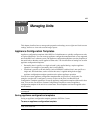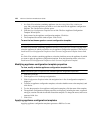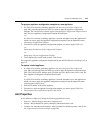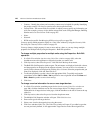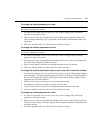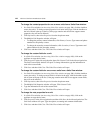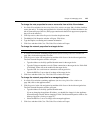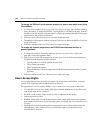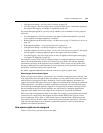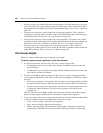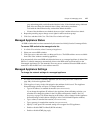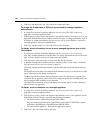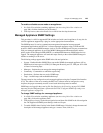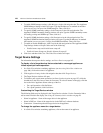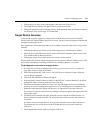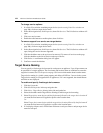
Chapter 10: Managing Units 145
• Configure unit settings - see Target Device Settings on page 150
• View data logging - this access right can be set only for target devices connected to appliances
that support data logging; see Chapter 13 beginning on page 185
For certain managed appliances, you may specify whether a user or members of a user group are
allowed to:
• View the appliance in Units View windows (this right is enabled automatically if any other
access right for the managed appliance is enabled)
• Reboot appliance and disconnect sessions - see Rebooting on page 313 and Active Sessions on
page 176
• Flash upgrade appliance - see Upgrading firmware on page 314
• Configure unit settings - see Managed Appliance Settings on page 147
• Configure appliance local user accounts - see Local Account Settings on page 157 (this option
will not appear for managed appliances that do not support local user accounts)
• View data logging - this access right can be set only for appliances that support data logging;
see Chapter 13 beginning on page 185
For example, you may allow users to configure settings on a managed appliance, but not allow
them to reboot and disconnect sessions on it. Instead, you may allow a user who has appliance
administrator privileges on the target devices to establish a Video Viewer session, but not allow
that user to perform power control operations. Access rights may also be specified for all units in
the DSView 3 software system or for a specific unit.
By default, supported embedded units have the same access rights as generic units.
About target device access rights
When you assign access rights to a target device, any available session types may be selected, even
if the target device does not support them. For example, you may enable Video Viewer and virtual
media sessions to a target device that is attached to a serial console appliance, which does not
support virtual media. The target device access rights are not based on the valid type of connection
to that target device - the ability to establish a particular session type exists only when the target
device (through its managed appliance) supports it. Using the above example, if the target device
that was attached to the serial console appliance was later moved to a managed appliance that
supported virtual media sessions, the target device could then be accessed by that method.
Each access right is independent of other access rights. For example, you may enable virtual media
session access to a target device that supports it, but not enable KVM (Video Viewer) session
access to that target device. Since a virtual media session is launched from a KVM session, that
user would, in fact, not be able to open a virtual media session with that target device. The access
right only indicates that the user is allowed to perform the operation; it does not mean that the
operation can actually be performed.
How access rights can be assigned
There are several ways you may assign access rights.



